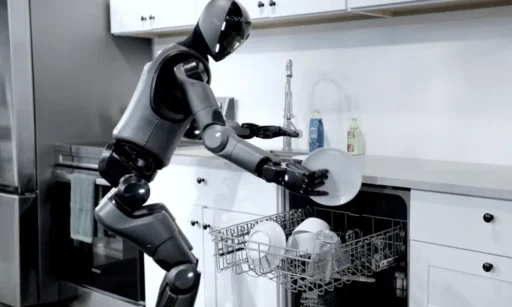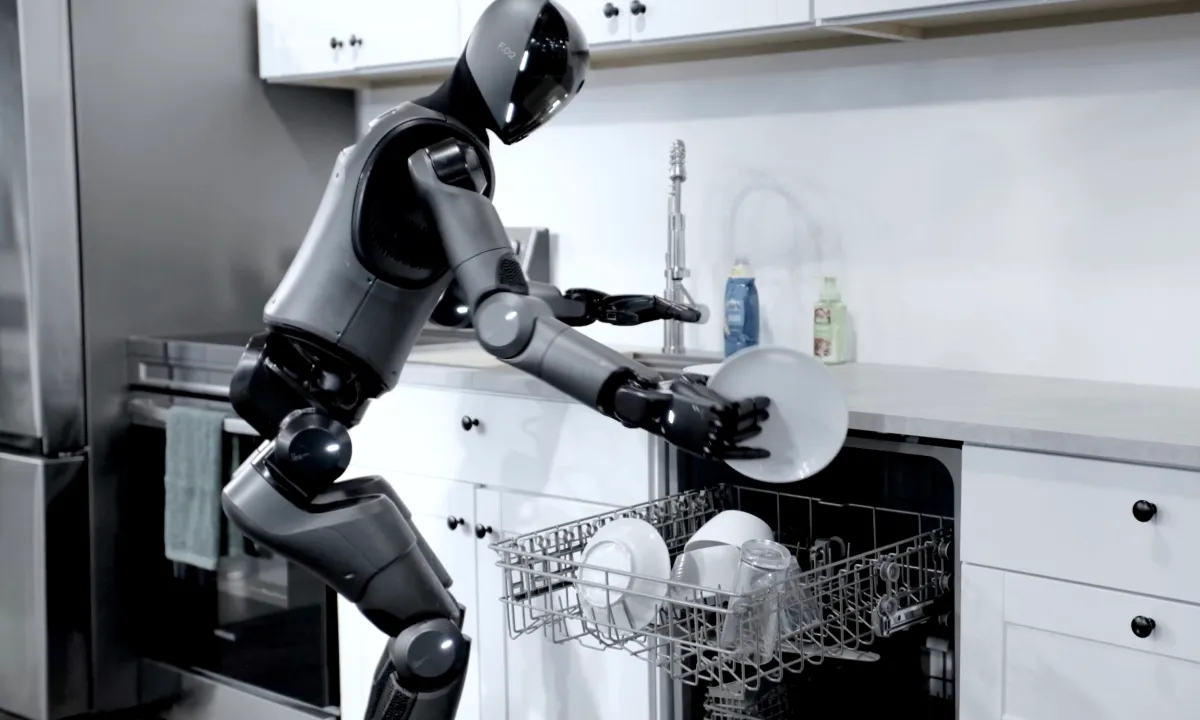Look, I’ll be honest – when I first saw Figure AI’s robot loading dishes, my immediate thought was “finally, someone cracked the code.” But then the skeptic in me kicked in. How many times have we seen flashy robot demos that fall apart in real-world conditions?
Here’s the thing though – this feels different. Figure AI’s humanoid robot just demonstrated something that could unlock a $40-117 billion consumer robotics market by 2030. And I’m not talking about another Roomba that bumps into walls. This is autonomous dishwasher loading with centimeter-scale precision using a unified neural network that doesn’t need task-specific programming.
The timing couldn’t be better either. Manufacturing costs for humanoid robots just dropped 40% in one year – from $50,000-$250,000 down to $30,000-$150,000 per unit. Meanwhile, 38% of Americans say they want household robots, and 87% specifically want automated dishwashing. That’s not a niche market anymore.
But here’s where it gets really interesting. Major tech companies just dumped over $675 million into Figure AI alone. When you see Microsoft, OpenAI, NVIDIA, and Jeff Bezos all writing checks, something big is happening.
Figure AI’s Tech Is Actually Pretty Wild
Okay, so what makes Figure AI different from all the other robotics companies that have burned through billions? It’s their Helix dual-system architecture, and honestly, it’s kind of genius.
They’ve got this System 2 component running a 7-billion parameter Vision-Language Model at 7-9 Hz for the “thinking” part. Then System 1 handles the actual finger movements with an 80-million parameter transformer running at 200 Hz. It’s like having a brain and nervous system working together.
Now, I know what you’re thinking – “great, another AI buzzword salad.” But here’s why this matters: the robot can separate cluttered dishes, figure out the best way to place them, and maintain precision even when everything’s slippery. That’s actually really hard to do.
The Figure 02 robot itself is pretty impressive too. It’s 5’6″ tall, weighs 70kg, runs for 5 hours on a charge, and can carry 20kg. More importantly, it processes everything onboard with embedded GPUs. No cloud dependency means no privacy nightmares and no internet outages killing your dishwashing.
Brett Adcock’s trajectory with this company is honestly insane. Founded in 2022, hit $2.6 billion valuation by February 2024, then jumped to $39.5 billion by 2025. That’s a 15x increase in less than a year. Either the market has completely lost its mind, or they’re onto something massive.
Here’s what really gets me though – the dishwashing capability wasn’t even programmed. The same AI system that handles factory work just learned to do dishes from about 500 hours of human demonstrations. Compare that to other systems that need thousands of hours of training data. If they can expand this to vacuuming, trash removal, and general home tasks as easily as they claim, we’re looking at a game-changer.
The Competition Is Getting Brutal
The humanoid robotics space is turning into a bloodbath, and I’m here for it. Tesla’s Optimus program is targeting $20,000-$30,000 consumer pricing with plans for 1 million units annually by 2029-2030. But here’s the reality check – they’ve only built hundreds of units versus the thousands they planned. Elon’s out here saying “by 2040, probably there are more humanoid robots than there are people,” which sounds great until you realize Tesla can’t even hit their current production targets.
Then you’ve got the Chinese manufacturers, and honestly, they scare me a bit. UBtech already secured 500+ orders from major automakers including BYD. China holds 5,688 humanoid robotics patents compared to just 1,483 in the US. Their government is basically throwing money at this problem with targets for mass production by 2025 and market dominance by 2027.
Boston Dynamics still has the coolest robots – their new electric Atlas can do backflips and probably beat me in arm wrestling. But they’re focused on industrial applications, not helping me with my dishes. Smart business move, but it leaves the consumer market wide open.
Here’s something that keeps me up at night though – look at iRobot’s Roomba success. 50+ million units sold, but they never successfully expanded beyond vacuuming. Robot vacuums cost $300-$1,500. These humanoid robots are projected to cost $20,000-$30,000. That’s a hell of a price gap to overcome.
But the VC money flowing in suggests people think it’s possible. We’re talking $2+ billion in recent venture capital across companies like 1X Technologies, Agility Robotics, and Physical Intelligence. Either we’re in the biggest robotics bubble ever, or this is the real deal.
The Technical Challenges Are No Joke
Let me tell you why robotic dishwashing is actually one of the hardest domestic tasks to automate. You need finger-level precision for fragile glassware, dynamic grip adjustment based on whether you’re holding ceramic or plastic, and real-time adaptation when that bowl decides to slip out of your grip.
Current systems can achieve sub-Newton force control with response times under 10 milliseconds. That’s approaching human-level sensitivity, which is genuinely impressive. But here’s where it gets tricky.
Water and electronics don’t mix. Period. You need IP65 protection standards, specialized sealing for rotating joints, corrosion-resistant materials like 316L stainless steel, and cable management that won’t fail when splashed. Dishcraft Robotics went out of business because they couldn’t solve the waterproofing problem. That should tell you something.
Then there’s the computer vision nightmare. Try recognizing objects when everything’s reflective, transparent, or covered in soap suds. Advanced multimodal sensing that combines cameras, tactile sensors, and force feedback can hit 96.5% accuracy versus 59% with vision alone. But that 3.5% failure rate? That’s your wine glasses getting smashed.
The AI/ML side is where things get really interesting. Large language models let you tell the robot “be careful with the good china” in plain English. Reinforcement learning helps it get better through trial and error. Figure AI’s unified neural network approach eliminates the need for task-specific programming, which is why they can expand to new tasks so quickly.
But let’s talk about the elephant in the room – safety. Water plus electricity plus autonomous operation near humans is a regulatory nightmare. We’ve got ISO 13482:2014 for personal care robots, but huge gaps for domestic robots. Who’s liable when your robot floods the kitchen? These questions need answers before this goes mainstream.
The Market Numbers Are Crazy
The consumer robotics market growth projections range from $40-117 billion by 2030-2033. That’s 22-29% compound annual growth rates. Household robots specifically could hit $24-96 billion by 2028-2034. Those are smartphone-level market sizes.
Here’s what’s driving this: aging populations need assistance, labor shortages are getting worse, and AI just crossed the threshold where previously impossible tasks are now doable.
Consumer data tells an interesting story. While 38% of Americans want household robots, only 7% expect widespread adoption within two years. The barriers? Cost (60% of consumers), reliability concerns (49%), privacy issues (48%), and safety fears (43%).
But here’s where the economics get interesting. Manufacturing costs dropped 40% in one year. Goldman Sachs thinks this trend will accelerate consumer adoption by 2-4 years ahead of schedule. Current home robot prices of $2,000-$5,000 could drop to $500-$1,500 by 2030. Humanoid robots are targeting that critical $10,000-$25,000 sweet spot for mainstream adoption.
Figure AI’s $39.5 billion valuation is the highest in robotics history. Physical Intelligence hit $2 billion in their first year. Total robotics funding was $10.6 billion in 2023, with $9.7 billion in just the first seven months of 2024. When this much money moves this fast, something big is happening.
Asia-Pacific is leading growth at 22% CAGR, driven by China’s government support, Japan’s robot-friendly culture, and South Korea’s $2.6 billion public-private partnerships. North America holds 35.3% market share with high consumer standards and regulatory frameworks. Europe focuses on sustainability and quality standards.
Smart Home Integration Is Make or Break
Here’s something most people miss – these robots need to play nice with your existing smart home setup. Amazon Alexa has 71% smart speaker market share, Google Home connects 50,000+ devices, and Apple HomeKit has its loyal following. The Matter protocol is trying to make everything work together, but it’s still messy.
Successful robots will function as mobile smart home hubs. They’ll coordinate with your thermostat, lights, security cameras, and everything else. Imagine your robot knowing to delay dishwashing when your smart meter detects peak electricity rates, or starting automatically when your security system arms for the night.
But privacy concerns are real. A robot with cameras and microphones operating 24/7 in your home creates unprecedented privacy risks. Local processing, encrypted communications, and transparent data policies aren’t just nice-to-haves – they’re requirements for consumer acceptance.
iRobot’s Roomba already works with Matter and Apple Home. Tesla plans integration across vehicles, energy systems, and home automation. But coordinating multiple devices across different platforms is complex. This complexity might slow adoption rates.
Safety and Regulations Are Lagging Behind
The intersection of water, electricity, and autonomous operation creates safety challenges that current regulations don’t address. Electrical safety standards require leakage currents below 10 mA and ground fault interruption within 6 milliseconds. When you’re dealing with wet environments, redundant protection systems become critical.
Chemical compatibility is another nightmare. Food-grade materials for dish contact, resistance to alkaline and acidic cleaners, protection against vapor exposure – it all requires specialized engineering. Multiple commercial dishwashing robot ventures failed because they couldn’t handle the chemical environment.
Human-robot interaction safety needs collision detection, force limiting, speed restrictions near humans, and emergency stops under 2 seconds. AI-based predictive safety systems can anticipate human movements and avoid collisions, but they’re not foolproof.
Regulatory frameworks are scattered across jurisdictions with significant gaps. The US lacks specific robotic standards beyond general machinery safety. Europe has CE marking and GDPR compliance requirements. Asian markets are developing their own national standards.
The liability questions are unprecedented. Who’s responsible when your robot causes damage – the manufacturer, software provider, or you? These legal frameworks need development before widespread deployment.
Economic and Social Impact Could Be Huge
Automation of household tasks represents significant economic change with complex labor implications. Research shows adding one robot per area reduces employment by about six workers, with disproportionate impacts on different groups. Men see 3.7 percentage point employment reductions versus 1.6 for women. Non-White workers face 4.5 point reductions versus 1.8 for White workers.
But here’s the flip side – women perform 75% of unpaid domestic work globally. Household automation could dramatically benefit women’s economic participation and career advancement. With 25%+ of populations over 65 by 2060 in developed countries, care labor shortages create opportunities for robotics to fill gaps.
Productivity benefits extend beyond individual households. Robotics investment contributed 10% of GDP per capita growth in OECD countries. Service sector analysis suggests 39% of domestic task time could be automated within 10 years. Manufacturing shows 15-30% throughput increases and 20-50% scrap reduction from automation.
The total economic impact remains modest relative to overall employment – an estimated 360,000-670,000 jobs lost to robots since 1990 in a 130+ million job US economy. But concentrated impacts in specific sectors and demographic groups create localized challenges requiring policy attention.
Environmental Impact Is Complicated
Household robotics presents mixed environmental implications that require careful analysis. Optimized robotic dishwashing can reduce water consumption by 25% versus manual washing and eliminate 11x more pollution than comparable automated systems. AI-powered systems achieve 25% faster cycles with 20% lower electricity consumption.
But manufacturing environmental costs include rare earth materials for sensors and motors, complex semiconductor fabrication for AI chips, and energy-intensive precision manufacturing. Most lifecycle assessments focus only on operational efficiency while ignoring upstream production impacts.
Circular economy implications depend on design choices around component recyclability, software longevity, and upgrade pathways. E-waste concerns from complex robotic systems require biodegradable sensor development, modular designs for component replacement, and take-back programs for end-of-life processing.
World Economic Forum research indicates robotics can enable 46% of UN Sustainable Development Goals while potentially inhibiting 19% through inequality exacerbation. Strongest positive impacts occur in industry and environment goals, while social inequality concerns need policy attention.
When Will This Actually Happen?
Expert consensus suggests household robotics follows a 10-15 year timeline for mass market viability. We’re in the early adopter phase through 2027. Stanford’s AI100 report projects household manipulation capabilities “perhaps around 2025.” Gartner forecasts 80% of humans engaging with smart robots daily by 2030.
The question isn’t if humanoid robots will do dishes in most homes – it’s when this becomes economically viable for average consumers.
Near-term (2025-2027): Figure AI starts alpha testing in homes beginning 2025. Tesla continues limited Optimus production for internal use. Boston Dynamics expands factory pilots. We’re still in innovation and early adopter phases with high costs and limited functionality restricting adoption to affluent consumers willing to pay premium prices.
Medium-term (2028-2032): This period depends on hitting critical cost reductions below the $10,000 consumer adoption barrier, reliability improvements reaching 95-99% success rates, and regulatory framework development. Price accessibility through 50-70% cost reductions could enable mainstream adoption while AI improvements allow more complex household automation.
Long-term (2033-2040): This timeframe includes Elon Musk’s prediction of “more humanoid robots than people by 2040” and the transition from early adopters to mass market penetration. But this timeline depends on solving current technical limitations including battery life (currently 2-5 hours), environmental adaptability, and human-robot interaction safety.
Comparing to smartphones, electric vehicles, and smart homes, robotics faces unique challenges including physical manipulation requirements, higher safety standards, and displacement rather than enhancement of existing solutions. Unlike purely digital technologies, household robots must solve real-world engineering challenges while achieving automotive-grade reliability.
My Take: We’re at the Inflection Point
Figure AI’s dishwashing demonstration isn’t just another tech demo – it’s proof that we’ve hit the commercial viability threshold for household humanoid robots after decades of hype and disappointment. The convergence of AI advances, manufacturing cost reductions, and market demand has created conditions for real transformation within the next decade.
The technical sophistication of Figure’s Helix system – operating at 200 Hz with finger-level precision across 35 degrees of freedom – proves that humanoid robots performing complex household tasks with human-level competence isn’t science fiction anymore. The $39.5 billion valuation and massive investor interest reflect institutional confidence that robotics has reached an inflection point comparable to early smartphones or electric vehicles.
But let’s be real about the barriers. Cost reduction below $10,000 for consumer adoption, reliability improvement to 95-99% success rates, and regulatory framework development are critical milestones we haven’t hit yet. Consumer concerns about privacy, safety, and job displacement need addressing as the technology matures.
The competitive landscape will likely consolidate around companies that successfully integrate AI capabilities, manufacturing scale, and ecosystem partnerships. Figure AI has early commercial deployment advantage. Tesla brings automotive manufacturing expertise. Chinese manufacturers offer cost advantages. Success requires both technological innovation and business execution excellence.
Drawing from insights in product development strategies for emerging markets and patterns in technology adoption cycles for consumer products, I think we’re looking at a household robotics revolution that will transform domestic life as fundamentally as previous automation waves transformed manufacturing and agriculture.
The question isn’t whether household robots will achieve widespread adoption anymore. It’s how quickly we can overcome the remaining technical, economic, and social barriers to make this transformation happen. And based on what I’m seeing, it’s going to be faster than most people think.






